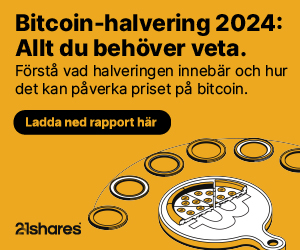Nyheter
Cosmos (ATOM) Research Primer
Publicerad
5 månader sedanden
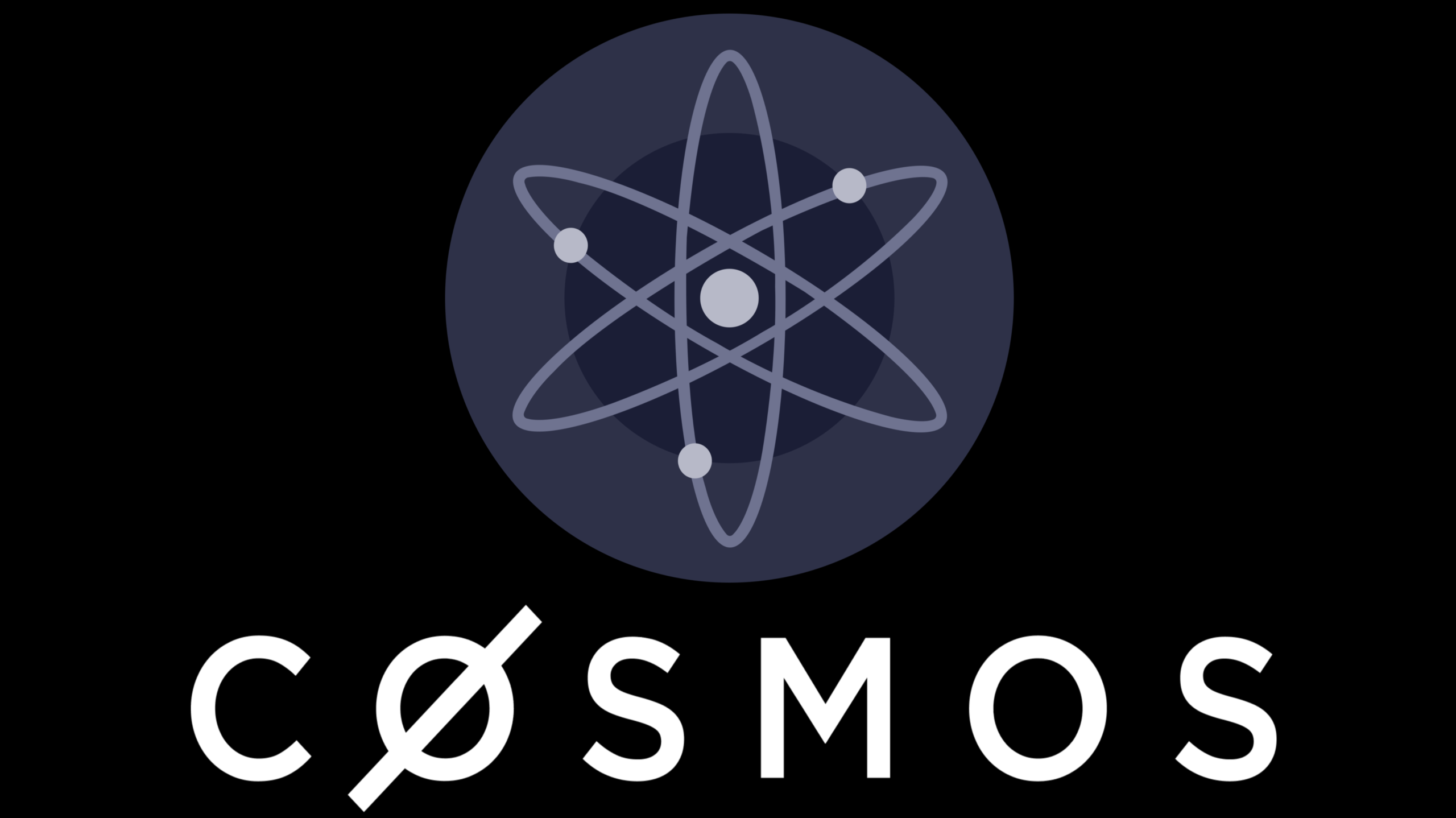
Cosmos was co-founded by Jae Kwon and Ethan Buchman in 2014, with the support of the Interchain Foundation (ICF), a Swiss company that supports R&D for secure, scalable, open, and decentralized networks. The ICO of the cosmos’ native token ATOM was released in 2017, and the network was ready to use two years later. So far, Cosmos raised a total of $17M in its seven rounds of funding led by Paradigm and followed by 1confirmation, IOSG Ventures, Yield Ventures, Cardinal Capital in addition to Kenneth Bok, managing director of Blocks, a Web 3 advisory based in Singapore.
Cosmos is building a network of crypto networks, which all have access to open-sourced tools for streamlining transactions between them. Customizability and interoperability are its two main selling points. Fueled by BFT consensus algorithms like Tendermint (also co-founded by Kwon and Buchman) and its token — Cosmos wants to be home for an ecosystem of networks that can exchange data and tokens programmatically and in a decentralized manner.
In this report, we will offer an exhaustive overview of the Cosmos network, ATOM as a crypto asset, and discuss the various investment risks associated with ATOM — in addition to how an investor can think about the future value of its underlying cryptoasset. In addition, this report offers exhaustive coverage of Cosmos and
ATOM available on the market.
Figure 1: ATOM Key Metrics (Source: CoinGecko)
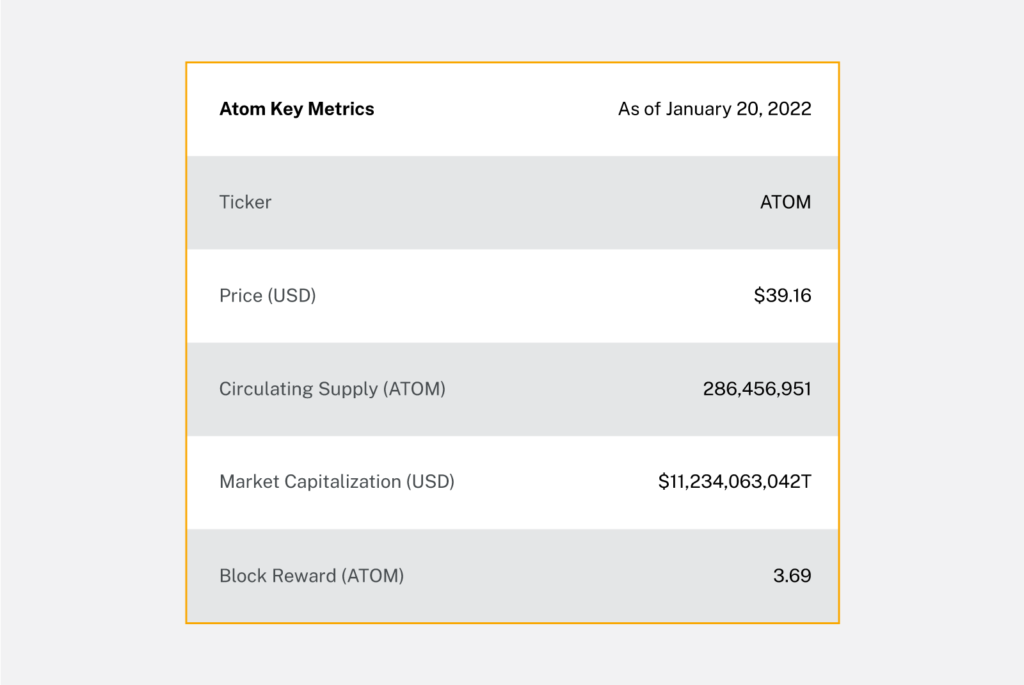
Figure 2: 1-Year Historical Performance (Source: CoinMetrics)
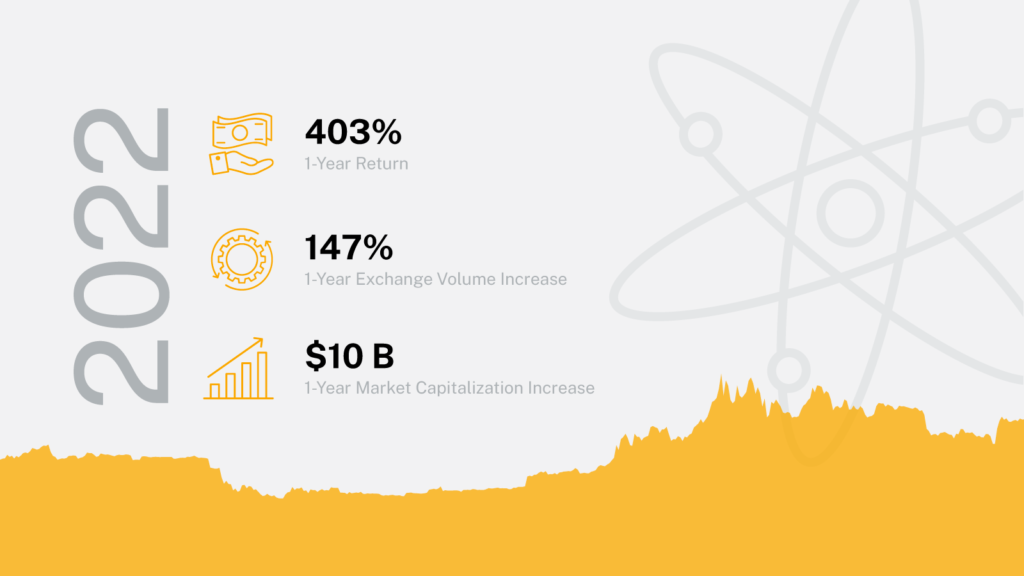
How Cosmos Works
The founders behind Cosmos came to find blockchains working in silos, unable to communicate with each other and struggling to make big transactions at once. Cosmos wanted to fix these problems by proposing a system with two classes of blockchains, Hubs and Zones. Zones are regular heterogeneous blockchains that are kept connected by the Hubs.
To make the vision of interoperability and customization work, Cosmos has three foundation stones in place, Tendermint, Inter-blockchain Communications Protocol (IBC) and Cosmos SDK.
• Tendermint helps developers build blockchains without having to code them from scratch, powered by the Tendermint Core, which is a PoS governance mechanism that keeps blockchains, or Zones, run in sync within the Cosmos Hub, the first Hub to be launched on Cosmos.
• IBC is a mechanism that makes information travel freely and securely between the Zones.
• To keep complexity to the minimum, the Cosmos SDK provides the Zones with most common functions like governance, tokens, and staking. If need be, developers can also add plugins for additional features or services.
A Zone is only required to create an IBC connection with a Hub, to exchange data and assets with other Zones connected to that Hub. That means Zones only need to establish a limited number of connections with a restricted set of Hubs instead of having to make a connection with each and every Zone. This system prevents double spending among Zones, because when a Zone receives a token from a Hub, it only needs to trust the origin Zone of this token and the Hub.
The Hub maintains and tracks the state of each Zone thanks to a steady stream of block commits from each zone that is connected to the Hub. Similarly, each Zone maintains track of the Hub’s status, however the Zones themself only keep up with each other indirectly through the Hub. Powered by the IBC protocol, information packets are then exchanged from one Zone to another by publishing Merkle-proofs as proof that the data was sent and received.
Blockchains are composed of three layers, Application, Consensus, and Networking.
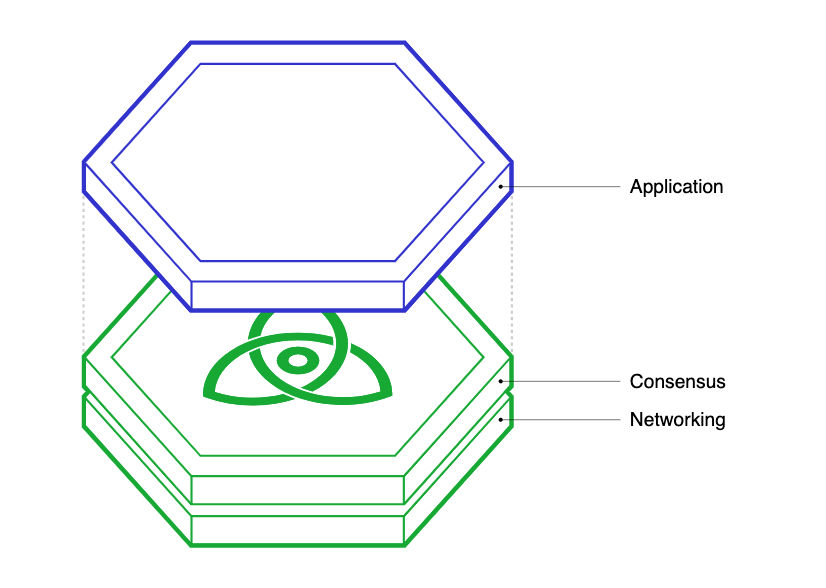
Application – Responsible for updating the state given a set of transactions, i.e. processing transactions.
Networking – Responsible for the propagation of transactions and consensus-related messages.
Consensus – Enables nodes to agree on the current state of the system.
Tendermint takes care of the last two layers, packaging them into a generic engine, the Tendermint Byzantine Fault Tolerance (BFT) engine, to give developers space to concentrate on building their application layers. The Tendermint BFT solution also fixes the limitation of sovereignty, that way developers don’t need to wait in long queues to get their transactions or other requests validated, as it is for application layers built on top of Ethereum for example. The Tendermint BFT engine is also connected to application layers by the Application Blockchain Interface (ABCI), a socket protocol that can understand any programming language developers wish to choose to meet their needs.
Blockchains that use fast-finality chains, or in other words Proof of Stake, can connect with Cosmos using the IBC protocol. However, blockchains that use probabilistic finality chains, or Proof of Work mechanisms, would find it challenging to connect to the network such as Bitcoin and Ethereum. That is exactly why Cosmos created a special proxy-chain called the Peg-Zone that bridges non-Tendermint blockchains by tracking the state of the blockchain in question. Peg-Zones have fast-finality and are therefore compatible with the IBC protocol allowing it to establish finality for the non-Tendermint blockchain it bridges.
The ATOM Token
ATOM is the native token of the Cosmos Hub, the very first blockchain that has been launched within the Cosmos network. However, due to the architecture of Cosmos, which potentially represents an ecosystem of thousands of different blockchains, each chain that is plugged into the Cosmos network will be able to use its own native token, which means Cosmos will be supporting many tokens in the future.
ATOM itself works similar to other Layer 1 utility tokens and allows stakeholders of the network to:
- Pay network fees when transferring assets or interacting with applications
- Staking, by bonding ATOM in order to earn block rewards, while securing the network
- Participate in governance and vote on proposals
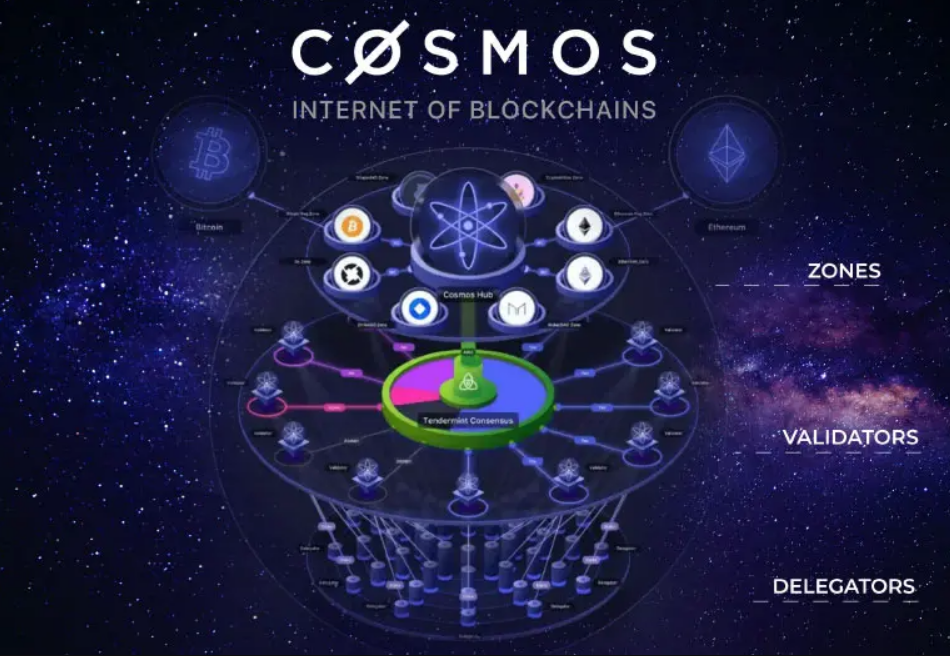
Token Distribution
In 2017, the Interchain Foundation had several private sales, followed by a public sale in April for roughly $17.6M.
The initial token distribution looked like the following:
5% went to the ICF’s initial donors
10% went to the Interchain Foundation (ICF).
10% went to All in Bits, Inc. (AIB), the corporation behind Tendermint.
75% has been distributed according to the results of the private (68%) and public fundraisers (7%).
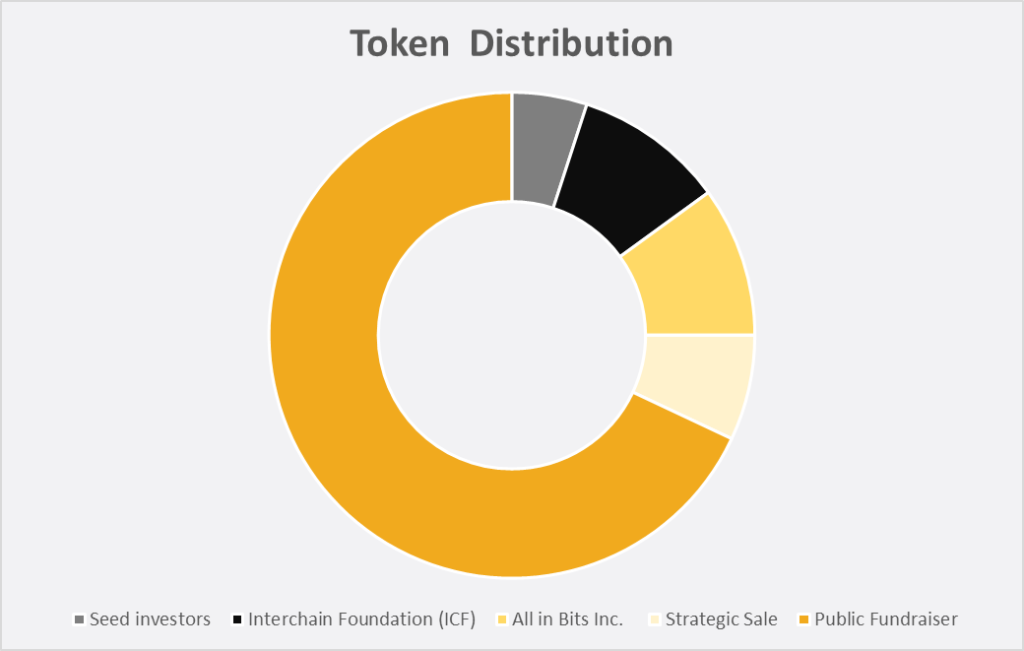
The State of Cosmos
Cosmos has rolled up its sleeves for a series of partnerships as well as new project launches to amplify its user experience and add more value to its network, making it more interoperable and easy to integrate. As of 30th of September 2020, eligible users on Coinbase have the opportunity to stake ATOM on the cryptocurrency exchange platform, collecting 5% rewards on their holdings. CoinDesk reported in October 2020, Cosmos gained some traction at Vellore Institute of Technology in southern India among students that compose “Cosmos India,” a community that grew from only a few members to more than a thousand in less than nine months.
In March 2021, Tendermint announced the launch of the biggest investment vehicle for the Cosmos ecosystem, a $20 million venture fund to boost development. The announcement came right after the activation of the IBC protocol, changing the game of DeFi on the network. In July, Cosmos got its own DEX protocol, Gravity launched to enable DeFi across multiple chains. Secured by over $3 billion in digital assets, swaps and pools between any connected blockchains are made possible on the Cosmos Hub.
In July, Tendermint announced it was building a crypto app store called Emeris that would allow access to a range of decentralized applications, such as lending protocols and decentralized exchanges, all in the Cosmos ecosystem. The beta version of Emeris launched in September 2021 and is set to publicly launch in spring 2022. Emeris is said to lift the Cosmos user experience to new heights, help unleash the potential of Cosmos DeFi and take it to a wider audience.
On Emeris beta, users can transfer and trade assets between 12 different chains for the first time, access a decentralized exchange, with a trusted, stable and audited DEX protocol. Users can also earn competitive yield by participating in liquidity pools. As of writing, the average swap speed is 00.07 seconds and the average transaction fee is $0.08 in addition to a swap fee of 0.3%. Emeris aims to be the first one-stop portal to provide integrated wallet and multi-wallet support, access to multiple DeFi trading platforms, staking on multiple chains, and also a mobile wallet app.
Also in July, Cosmos announced it’s banding with cross-chain data oracle Band Protocol to integrate with Starport, a development tool for the Cosmos blockchain allowing third-party developers to gain access to numerous new data feeds, such as token information, real-world events, sports, weather, and random number generation. This partnership meant that newly created chains in the Cosmos ecosystem would be able to exchange data via the IBC protocol, making the network even more interoperable and accessible.
Cosmos’ cross-chain DEX Osmosis announced in January 2022 that it’s expanding its horizons with the launch of a new bridge, the Gravity Bridge, that would enable trading for Ethereum-based assets. The Gravity Bridge will act as an IBC to Ethereum translator, it will be built by internet services provider Althea.
Cosmos Ecosystem
As mentioned before, the first blockchain resident in the Cosmos ecosystem was the Cosmos Hub, launched by Cosmos itself and under which Zones run in sync. There’s an accelerating number of projects growing within the Cosmos network, including Terra (LUNA), ThorChain, Secret Network, Compound Gateway, Osmosis, Kava, and Akash.
The Future of Cosmos
There are quite some exciting milestones on the Cosmos roadmap for the year 2022. Obviously, one of the most important objectives is to onboard more blockchains that will plug into the Cosmos Network and ensure a seamless communication between them using IBC. However, there are also some powerful updates and features down the road, including Interchain Accounts, Interchain Security, Liquid Staking, and an expansion of its DeFi and NFT ecosystem.
The first upgrade that is expected in Q1 2022 is the Theta Upgrade. This will introduce Interchain Accounts, Liquid Staking and an NFT module, which will set the base for Cosmos’ NFT ecosystem. Interchain Accounts will leverage IBC and allow users to own, manage and transfer their tokens throughout the entire interoperable ecosystem and access blockchain-specific applications from one single account. One account to rule them all!
Currently almost 60% of all ATOM in circulation is being staked, rewarding contributors with a yield up to 13% per year. With the introduction of the first version of Liquid Staking, which is planned to be released as early as February 2022, this number is most likely to increase. Liquid Staking will allow users to stake their ATOM with no lock-up period, while also receiving a derivative of their bonded assets, which they ultimately can use for liquidity mining or other DeFi activities.
Interchain Security is another key feature that will be implemented with the Rho Upgrade, which is expected to take place in Q2 2022. It will enable Cosmos chains to effectively lease a set of security services to one another, allowing new chains to bootstrap their ecosystems, while enjoying solid security features right from the start. By staking ATOM on the Cosmos Hub, validators and delegators will be able to collect rewards on multiple chains in different tokens. ATOM stakers will therefore benefit from early access to new and innovative projects and greater token utility, while at the same time allowing new chains to get exposure of their tokens to Cosmos community members early on.
Cosmos’ ambition is to connect 200 blockchains in the year 2022. This would obviously unlock an unprecedented amount of liquidity and capital flows throughout all connected blockchains, which would be a massive tailwind for Cosmos’ DeFi. Moreover, UX and UI is still a massive challenge in DeFi and the crypto space in general, however, with the implementation of Emeris, the internet of blockchains will get a professional looking interface to track and manage assets. Emeris currently focuses on portfolio visualization, digital asset management and service discovery and will soon bring features like auto-compounding staking, airdrop tracker and cross-chain DEX aggregation.
On paper, the future Cosmos looks bright. If the internet of blockchains potentially solves one of the biggest obstacles in crypto, the lack of interoperability, and succeeds in connecting thousands of layer 1s and applications, this could mean a massive boost not only for the Cosmos network but for the entire crypto space.
Valuing Cosmos
A quantitative and qualitative evaluation of a crypto asset’s intrinsic value can be derived from a few key fundamentals. The first way we can think of when assessing the potential value of Cosmos’ native asset, ATOM, is carrying out a market sizing exercise to compare its value to that of its main competitors as its target market. By also looking at the total addressable market, we would be able to evaluate the factors that contribute to ATOM’s value. The final method would be using two metrics, number of transactions and their respective fees, to compare the revenue share.
Market sizing
The chart below shows the current market capitalization of Cosmos compared to Ethereum, Solana, Terra, Avalanche and Polkadot. Ethereum represents what the market has judged as the current best use-case of blockchain technology while the smart contracts use case can be argued to be just as valuable in the long term. However, Avalanche with its Subnets or Polkadot with its Parachains are comparable projects with a more similar network architecture and serve as comparison for ecosystem development.
The bull case for Cosmos is that it fulfills its vision as the “Internet of Blockchains’’ connecting thousands of crypto asset networks such as Ethereum, Solana, Fantom or even Polkadot; in a similar way to the internet is a decentralized network that connects individual platforms such as Facebook, Amazon and Google. Even though applications can be deployed on the Cosmos Hub blockchain itself, the majority of value and the future potential is derived from the rate of adoption of Comos as the primary hub for interoperability between various Layer 1s. Looking at the current blockchains and projects that are plugged into the Cosmos network, which includes prominent players like Terra and Binance, we can see that the combined market cap, according to the Cosmos website, sits at $157B with a total of 49 apps and services. Although only 28 of those are currently active and IBC-enabled, this theoretically still makes it the second biggest ecosystem after Ethereum, which as of writing this report holds a market capitalization of $380B. Comparing the price and the state of the network to its closest competitor Polkadot, we could assume that Cosmos is currently undervalued.
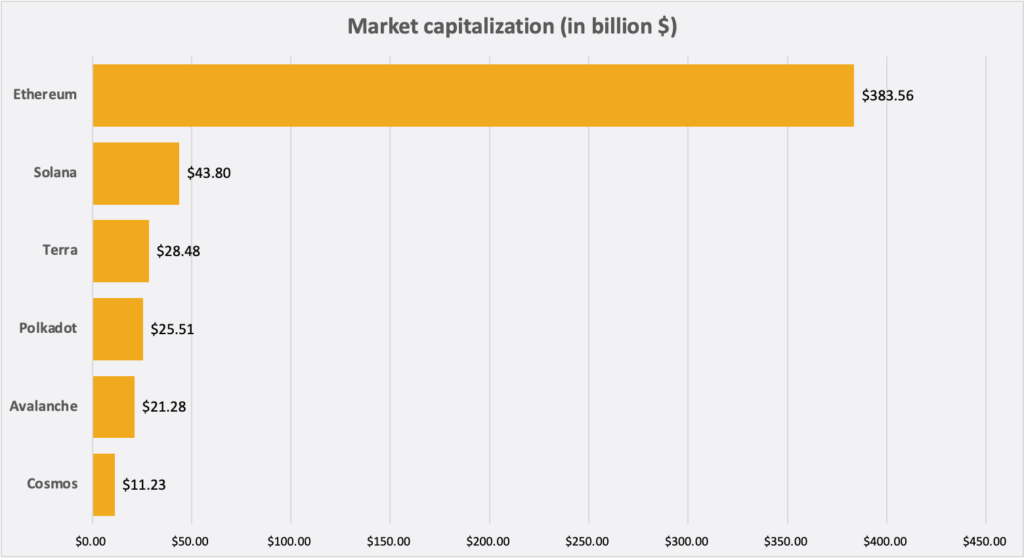
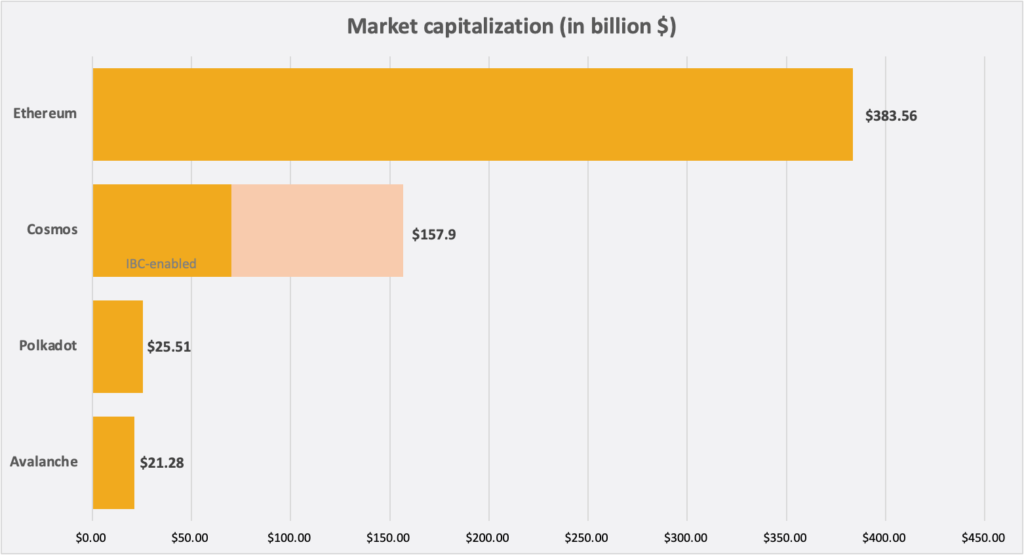
Total Addressable Market
It’s important to note that Cosmos doesn’t necessarily compete with other projects, unlike the current rivalry between Layer 1s. It’s potential total addressable market is therefore the entire crypto market, leveraging the Cosmos Network as the underlying Layer 0, tying everything together. If we would assume Metcalfe’s law, which states that the value of a network is proportional to the square of the number of connected users, that means that Cosmos could see exponential growth when continuing to plug in new blockchains into its ecosystem. This ultimately wouldn’t only increase the value of ATOM, but every crypto network that’s being part of the network. This is a win-win situation for all parties involved.
Revenue
Revenue generation is often a key metric when assessing network value. By assessing the total number of transactions and the average cost per transaction we are able to estimate the total revenue generated. Fees and revenue are a good signal for the overall demand for a given smart contract platform and arguably the strongest barometer of fundamental growth. Cosmos’ estimated total annualized revenue currently sits at around $1.38M, which is obviously minor compared to Ethereum’s $15B, yet an indication of the potential upside for the project. Taking into account the various upgrades and upcoming milestones on the roadmap, the probability of this trend to continue seems very likely in tandem with increased demand and therefore more economic activity on the Cosmos Hub.
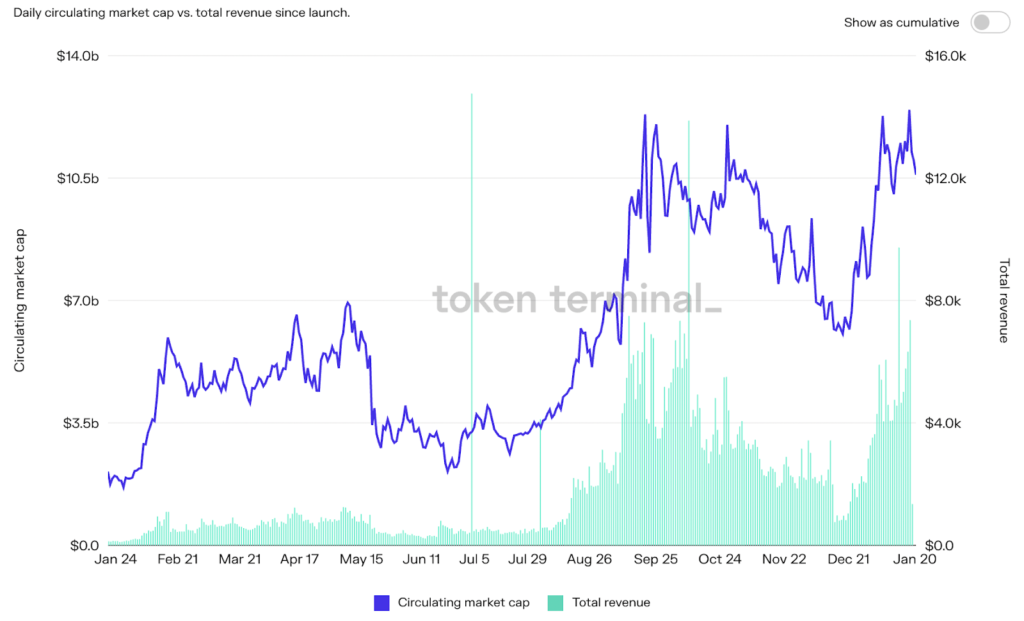
Risks
Technology Risks
Even though the Cosmos mainnet launched in March 2019, the network itself is still in an embryonic state. The network is still evolving by implementing new upgrades and changes to the protocol, which could introduce bugs, code vulnerabilities, or adversely affect the crypto network. These smart contract failures and other technical issues that will only be fathomable in hindsight not in foresight due to the fact that this is a novel technology. This is a risk that essentially all crypto projects are exposed to. However, at 21Shares, we’ve monitored the Cosmos ecosystem and saw how the Tendermint consensus mechanism was widely battle tested. With LUNA being the largest real-world application alongside Cosmos, our thesis is that only time, and the development that happens underway, will prove how efficient consensus becomes.
Financial Risks
The cryptocurrency market is known for its tremendous volatility, making it a risky investment. If the price of a token declines suddenly, an investor stands to lose a lot of money. Crypto projects are still considered to be risk-on assets, therefore macroeconomic dynamics can have a significant impact on price movements and volatility. Investing in crypto assets is nothing for the fainthearted, as many investors are unable to cope with the severe ups and downs. The crypto space is continuously changing, with both benefits and problems. As mentioned above, the Cosmos network is still in its infancy, therefore investors will see themselves exposed to an innovative and bleeding edge technology, which obviously bears certain financial risks, while offering an attractive potential upside.
Regulatory Risks
Like many other crypto projects, Cosmos was initially funded by a private token sale and ICO and is therefore potentially vulnerable to some level of regulatory scrutiny. However, due to Cosmos’ decentralized network infrastructure and used as a payment mechanism,, it is less likely to be on the radar of regulatory authorities. Therefore the likelihood of serious regulatory scrutiny from any governmental body for Cosmos itself is relatively low. Although this doesn’t include regulations that might impact the crypto space as a whole, Cosmos sits in a relatively safe spot compared to other crypto assets.
Research Newsletter
Each week the 21Shares Research team will publish our data-driven insights into the crypto asset world through this newsletter. Please direct any comments, questions, and words of feedback to research@21shares.com
Disclaimer
The information provided does not constitute a prospectus or other offering material and does not contain or constitute an offer to sell or a solicitation of any offer to buy securities in any jurisdiction. Some of the information published herein may contain forward-looking statements. Readers are cautioned that any such forward-looking statements are not guarantees of future performance and involve risks and uncertainties and that actual results may differ materially from those in the forward-looking statements as a result of various factors. The information contained herein may not be considered as economic, legal, tax or other advice and users are cautioned to base investment decisions or other decisions solely on the content hereof.
Du kanske gillar
-
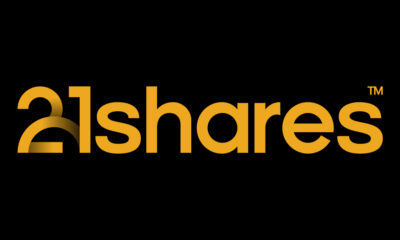

Navigating Macro Headwinds, On-Chain Optics, and The Rise of Runes
-
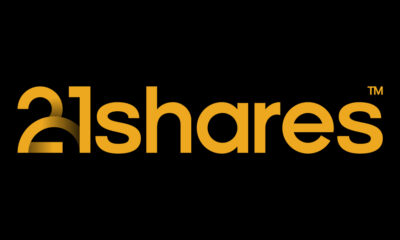

The Bitcoin Halving and Beyond
-
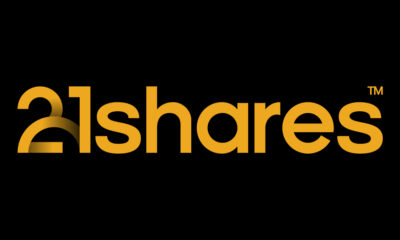

Geopolitical Conflict on the Rise, while Ethereum Receives its Biggest Boost
-
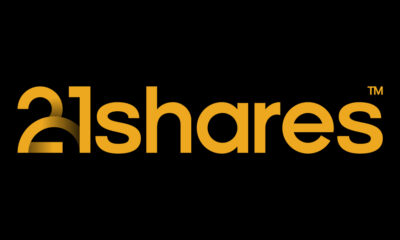

Bitcoin Shakes off FUD While Solana Gets Help
-
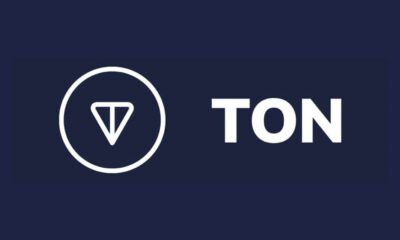

TONN ETP replikerar utvecklingen av Toncoins prisutveckling
-
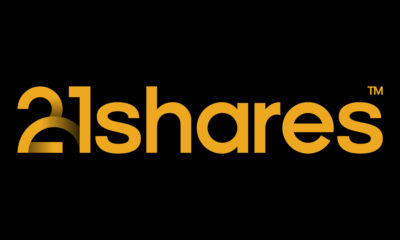

All-Time Highs, Dramatic Gas Reduction, and Tokenization
Nyheter
Inevitable in India: Crowds, cricket and capital gains tax
Publicerad
45 minuter sedanden
28 april, 2024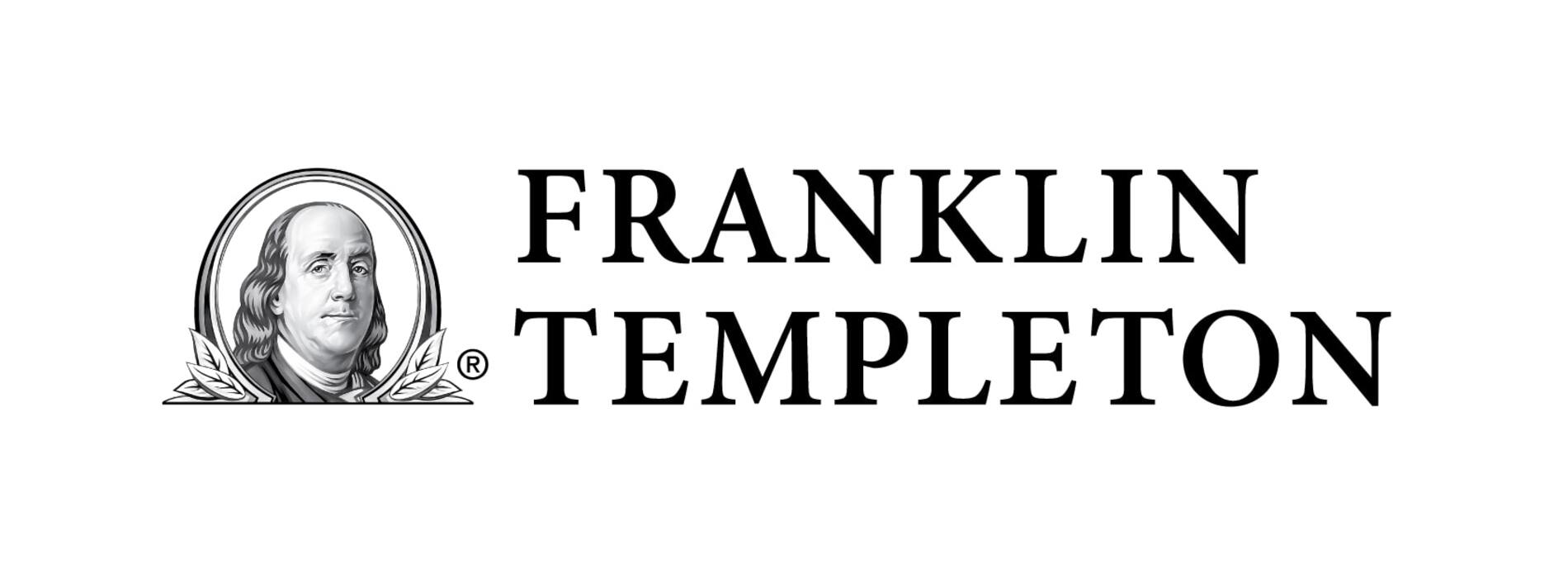
India’s vibrant economy and structural growth opportunities continue to be the envy of many emerging markets. But somewhat unique to this market are tax implications that investors should be aware of. Our Franklin Templeton Global ETF team examines these structural issues in Asia’s third-largest economy.
In merely a decade, India has taken a quantum leap from the world’s 11th largest economy to become its fifth largest. By many accounts, it is expected to remain one of the world’s fastest-growing major economies over the coming years. And even after a banner 2023 during which the country’s benchmark indexes surged and Indian Prime Minister Narendra Modi celebrated high-profile successes—from historic technological and space exploration achievements to rising global diplomatic clout—this election year has already marked more progress in supporting Modi’s pro-growth, pro-jobs efforts.
The world’s most populous nation has advanced ties with Western countries over free trade. In addition to agreements with Australia and the United Arab Emirates, it has worked to better integrate the “Global South’s” development needs and ambitions with that of the G20. Modi has touted innovative partnerships for a new multilateral rail and sea corridor to connect India with the Middle East and the European Union (EU)—seen as a counterweight to China’s vast Belt-and-Road infrastructure corridor.
India reached its latest notable trade pact, nearly 16 years in the making, in March with the European Free Trade Association—Iceland, Liechtenstein, Norway and Switzerland. The agreement lifts Indian tariffs to secure US$100 billion in foreign direct investment commitments from the non-EU markets to India across multiple sectors.
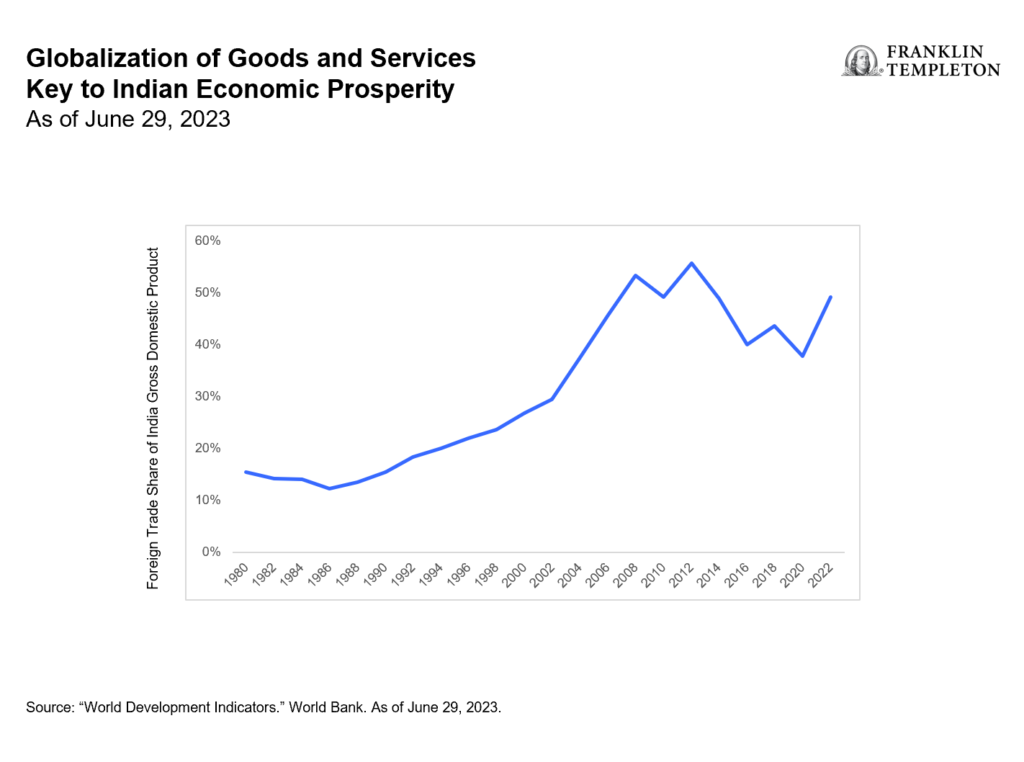
With India still an enviable investment powerhouse, it seems important to clarify a few aspects of this dynamic equity market.
How exchange-traded funds (ETFs) treat India capital gains tax (CGT)
Foreign investors should be aware that CGT is an integral part of investing in Indian equities that cannot be circumvented. Investors in India funds are subject to CGT implications regardless of fund provider, and CGT is based and calculated on a fund as a whole, not an individual investor’s position.
The details: Foreign investors owning local Indian stocks are subject to taxation on capital gains at a short-term rate of 15% for positions held for less than one year and at a long-term rate of 10% for positions held over one year.
To accrue or not to accrue: Consistent with market practice for US-listed India ETF providers, Franklin Templeton accrues unrealized CGT in its daily net asset value (NAV). This can lead to differences in performance relative to the benchmark, which does not include CGT. As a result, rising markets will typically lead to fund underperformance against a benchmark, while weaker market environments will typically generate outperformance (provided the fund is in an unrealized capital gain position where the current market value of fund holdings is above their historical book cost). See chart below.
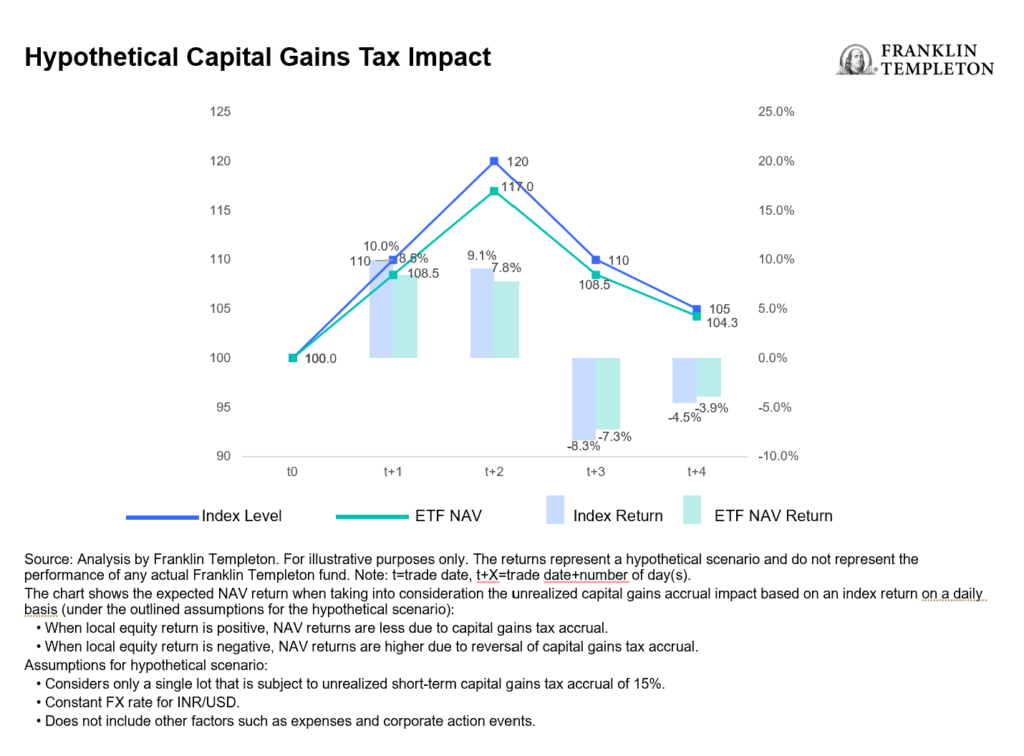
For UCITS-listed India funds, there is a divergence in methods utilized by fund providers in accruing and reporting CGT. Some do not accrue unrealized CGT in the NAV, but will charge CGT to investors directly at redemption, which we believe leaves investors with a level of opaqueness and uncertainty over their ultimate proceeds. This method also creates an elevated NAV compared to what investors will actually experience. While Franklin Templeton’s approach to CGT may at times lead to a higher tracking difference,1 we believe investors benefit from increased transparency and a more reflective experience.
The magnitude and impact of CGT for a specific fund is heavily dependent on several variables, such as the timing of purchases and sales, performance of the holdings and their volatility, and the size of flows in and out of the fund relative to its assets under management (AUM).
Understanding the impact: The CGT impact to fund performance is driven by the path of returns, timing of individual lots and price points. Very broadly speaking, in rising markets, an NAV-accruing fund will likely underperform its benchmark and vice versa.
Consideration of comparability: Because different providers handle CGT differently, the comparability of fund performance metrics may be affected. As investors, it’s prudent to consider how these nuances may influence investment decisions within the broader context of your financial strategy.
The bigger picture: While CGT considerations are important, they should be viewed within the broader spectrum of investment objectives and risk tolerance. Taking a long-term perspective and being mindful of other important characteristics of the investment vehicle of choice may aid in the decision-making process.
In summary, India remains an attractive investment destination with compelling growth prospects for its equity markets. Investors seeking India allocation through an ETF should be aware of the current tax regime and what varying methods of accounting methodologies really mean for fund valuation.
Nyheter
XB33 ETF köper företagsobligationer i euro som förfaller 2033
Publicerad
2 timmar sedanden
28 april, 2024
Xtrackers II Target Maturity Sept 2033 EUR Corporate Bond UCITS ETF 1D (XB33 ETF) med ISIN LU2673523564, försöker följa Bloomberg MSCI Euro Corporate September 2033 SRI-index. Bloomberg MSCI Euro Corporate September 2033 SRI-index följer företagsobligationer denominerade i EUR. Indexet speglar inte ett konstant löptidsintervall (som är fallet med de flesta andra obligationsindex). Istället ingår endast obligationer som förfaller mellan oktober 2032 och september 2033 i indexet (ETF kommer att stängas i efterhand). Indexet består av ESG (environmental, social and governance) screenade företagsobligationer. Betyg: Investment Grade.
Den börshandlade fondens TER (total cost ratio) uppgår till 0,12 procent p.a. Xtrackers II Target Maturity Sept 2033 EUR Corporate Bond UCITS ETF 1D är den enda ETF som följer Bloomberg MSCI Euro Corporate September 2033 SRI-index. ETFen replikerar det underliggande indexets prestanda genom samplingsteknik (köper ett urval av de mest relevanta indexbeståndsdelarna). Ränteintäkterna (kupongerna) i ETFen delas ut till investerarna (Minst årligen).
Denna ETF lanserades den 8 november 2023 och har sin hemvist i Luxemburg.
Bloomberg MSCI Euro Corporate SRI PAB Index syftar till att spegla resultatet på följande marknad:
- EUR-denominerade företagsobligationer
- Endast obligationer med investeringsklass
- Obligationer med en löptid på minst 1 år
- Minsta utestående belopp på 300 miljoner euro per obligation
- Endast obligationer utgivna av företag med en MSCI ESG-rating på BBB eller högre och en MSCI ESG Impact Monitor över 1 ingår
Indexet övervakar absoluta växthusgasutsläpp (“GHG”) genom att sätta en initial 50 % avkolning av absoluta växthusgasutsläpp i förhållande till moderuniversumet följt av en årlig 7 % avkolningsbana för absoluta växthusgasutsläpp.
Obligationer utgivna av företag som är involverade i alkohol, tobak, hasardspel, vuxenunderhållning, genetiskt modifierade organismer (GMO), kärnkraft, civila skjutvapen, militära vapen (inklusive minor, klusterbomber, kemiska vapen) är undantagna.
Handla XB33 ETF
Xtrackers II Target Maturity Sept 2033 EUR Corporate Bond UCITS ETF 1D (XB33 ETF) är en europeisk börshandlad fond. Denna fond handlas på Deutsche Boerse Xetra.
Det betyder att det går att handla andelar i denna ETF genom de flesta svenska banker och Internetmäklare, till exempel DEGIRO, Nordnet, Aktieinvest och Avanza.
Börsnoteringar
| Börs | Valuta | Kortnamn |
| XETRA | EUR | XB33 |
Största innehav
| ISIN | Namn | Vikt % | Land |
| IE00BZ3FDF20 | DEUTSCHE GLOBAL LIQUIDITY SERI | 0.54% | Irland |
| CH1214797172 | BBG01BFYVYX8 CREDIT SUISSE GROUP AG 3/29 | 0.18% | Schweiz |
| XS0525602339 | RABOBANK 07/25 | 0.14% | Holland |
| FR0000471930 | FRANCE TELECOM 01/33 | 0.13% | Frankrike |
| FR0013324357 | SANOFI SA 1.375% 2030-03-21 | 0.12% | Frankrike |
| XS1001749289 | MICROSOFT CORP 12/28 | 0.12% | USA |
| XS1372839214 | VODAFONE GROUP PLC 08/26 EUR51520 | 0.12% | Storbritannien |
| XS2461234622 | BBG0162QT3D3 JPMORGAN CHASE AND CO 3/30 | 0.11% | USA |
| XS2235996217 | NOVARTIS FINANCE SA 9/28 | 0.11% | Spanien |
| XS2705604234 | BBG01JPP1244 BANCO SANTANDER SA 10/31 | 0.11% | Spanien |
| FR0013398070 | BNP PARIBAS 01/26 AW746868 | 0.11% | Frankrike |
| XS2180007549 | AT&T INC 5/28 | 0.11% | Frankrike |
| XS2149207354 | GOLDMAN SACHS GROUP INC 3/25 | 0.10% | USA |
| XS1603892149 | MORGAN STANLEY DEAN WITTER 04/27 AN318761 | 0.10% | USA |
| CH0537261858 | CREDIT SUISSE GROUP AG SR UNSECURED REGS 04/26 VAR 4/25 | 0.10% | Schweiz |
Innehav kan komma att förändras
Nyheter
Ny ETF från Franklin Templeton investerar med katolska värderingar
Publicerad
3 timmar sedanden
28 april, 2024
En ny börshandlad fond utgiven av Franklin Templeton har varit handelsbar på Xetra och Börse Frankfurt sedan i torsdags. Denna ETF investerar med katolska värderingar.
Franklin MSCI World Catholic Principles UCITS ETF (FLXA) ger investerare tillgång till en brett diversifierad aktieportfölj med cirka 800 stora och medelstora företag på utvecklade marknader som anses vara miljömedvetna och socialt ansvarstagande.
Jämförelseindexet, MSCI World Select Catholic Principles ESG Universal and Low Carbon Index, syftar till att visa ett lägre koldioxidavtryck och en bättre miljö-, social- och styrningsprofil jämfört med MSCI World Index.
Undantagna är företag som är verksamma inom kontroversiella affärsområden som vapen, hasardspel, vuxenunderhållning eller är inblandade i abort, preventivmedel, stamcellsforskning och djurförsök.
| Namn | ISIN | Avgift % | Utdelnings- policy | Referens- index |
| Franklin MSCI World Catholic Principles UCITS ETF | IE000AZOUN82 | 0,27% | Ackumulerande | MSCI World Select Catholic Principles ESG Universal and Low Carbon Index-NR |
Produktutbudet i Deutsche Börses XTF-segment omfattar för närvarande totalt 2 157 ETFer. Med detta urval och en genomsnittlig månatlig handelsvolym på cirka 14 miljarder euro är Xetra den ledande handelsplatsen för ETFer i Europa.

Inevitable in India: Crowds, cricket and capital gains tax

XB33 ETF köper företagsobligationer i euro som förfaller 2033

Ny ETF från Franklin Templeton investerar med katolska värderingar

Playing the AI revolution through commodities and gold’s curious rally

ETBB ETF en utdelande fond som spårar Euro Stoxx 50

ETFmarknaden i Europa firar sitt 24-årsjubileum med tillgångar på två biljoner USD

De mest populära börshandlade fonderna mars 2024

Tillgång till obligationsmarknaden för företagsobligationer från utvecklade marknader

FUIG ETF investerar i hållbara företagsobligationer som följer Parisavtalet

Försvarsfond når förvaltad volym på 500 MUSD
Populära
-

 Nyheter2 veckor sedan
Nyheter2 veckor sedanETFmarknaden i Europa firar sitt 24-årsjubileum med tillgångar på två biljoner USD
-

 Nyheter4 veckor sedan
Nyheter4 veckor sedanDe mest populära börshandlade fonderna mars 2024
-

 Nyheter2 veckor sedan
Nyheter2 veckor sedanTillgång till obligationsmarknaden för företagsobligationer från utvecklade marknader
-

 Nyheter4 veckor sedan
Nyheter4 veckor sedanFUIG ETF investerar i hållbara företagsobligationer som följer Parisavtalet
-

 Nyheter2 veckor sedan
Nyheter2 veckor sedanFörsvarsfond når förvaltad volym på 500 MUSD
-
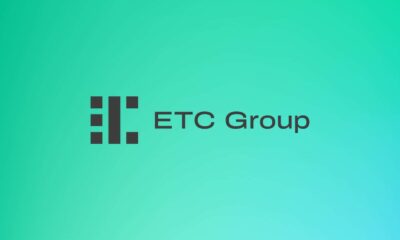
 Nyheter4 veckor sedan
Nyheter4 veckor sedanVad händer härnäst för Bitcoin?
-

 Nyheter3 veckor sedan
Nyheter3 veckor sedanNy börshandlad fond från Deka ger tillgång till S&P 500-index
-

 Nyheter4 veckor sedan
Nyheter4 veckor sedanInvestera i guldgruvor med ETFer


